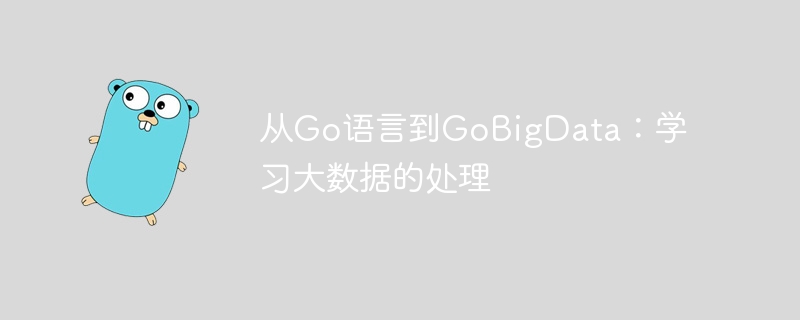Home >Backend Development >Golang >From Go language to GoBigData: learning big data processing
From Go language to GoBigData: learning big data processing
- WBOYWBOYWBOYWBOYWBOYWBOYWBOYWBOYWBOYWBOYWBOYWBOYWBOriginal
- 2023-11-30 10:26:25686browse

With the continuous development of the Internet, the scale and diversity of data continue to increase, and efficient processing of large-scale data has become an increasingly important issue. In this context, big data technology has been increasingly widely used, and the Go language, as a programming language with excellent performance, high reliability, and strong concurrency capabilities, is also widely used in the field of big data.
Features of Go language
Go language is an open source programming language, launched by Google in 2007 and released in 2009. Go language has the following characteristics:
- High performance: Go language adopts static compilation method, which can be compiled into native code and run directly on the operating system, so it has high performance.
- Strong concurrency capabilities: Go language has two built-in concurrency mechanisms, goroutine and channel, which can easily realize communication and data sharing between threads and implement a distributed system.
- Simple and easy to use: The syntax of Go language is very simple and easy to learn, and the language has a large number of built-in standard libraries that can solve many common problems.
- High reliability: Go language has a built-in garbage collection mechanism, which can automatically recycle memory, reduce the programmer's workload, and also avoid problems such as memory leaks.
Go language and big data processing
Big data processing needs to process massive data, and massive data often requires higher performance and concurrency capabilities. Therefore, Go language is a high-level language. A high-performance programming language with characteristics suitable for big data processing.
The Go language is suitable for building distributed systems. When the amount of data reaches hundreds of millions, the Go language can quickly process data in a concurrent manner without serialization bottlenecks.
The concurrency mechanism of Go language - goroutine and channel, allows developers to easily build distributed systems without having to worry too much about thread synchronization, locks and other issues. The concurrent programming paradigm based on goroutine can make it easier for developers to implement high-concurrency and high-throughput systems.
The standard library in Go language provides many functions related to big data processing, such as sort package, container package, bufio package, etc. These functions can help developers easily handle various big data problems, such as Sorting, deduplication, search, etc.
In addition, the Go language has many third-party libraries, such as Gorilla, Beego, GolangCrypto, etc. These libraries can help developers handle various big data problems more conveniently.
From Go language to GoBigData
To learn big data processing, you first need to learn some basic data processing algorithms and data structures. In this regard, the Go language provides a rich library of basic functions and data structures, which can reduce developers' workload and improve code readability and maintainability.
Learning big data processing also requires understanding of some basic distributed system knowledge, such as distributed storage, distributed computing, etc. The learning of this knowledge can allow developers to have a deeper understanding of all aspects of big data processing, and then combine it with the concurrency mechanism and standard library of the Go language to develop an efficient and reliable big data processing system.
At the same time, in order to better learn big data processing, the following aspects are recommended:
- Improve your algorithm and coding capabilities, and learn some common algorithms and data structures, such as Hash table, red-black tree, AVL tree, quick sort, merge sort, etc.
- Learn various big data processing technologies and tools, such as Hadoop, Spark, Storm, Kafka, Flume, etc.
- Learn related knowledge of distributed systems, such as Paxos algorithm, Raft algorithm, consistent hash algorithm, etc.
- Learn artificial intelligence technologies such as machine learning and deep learning. The combination of big data processing and artificial intelligence can produce very excellent application effects.
In short, to learn GoBigData, we need to accumulate a solid programming foundation, and we also need to continuously learn various knowledge and technologies related to big data processing. Only in this way can we adapt to the future of big data processing. develop.
The above is the detailed content of From Go language to GoBigData: learning big data processing. For more information, please follow other related articles on the PHP Chinese website!

